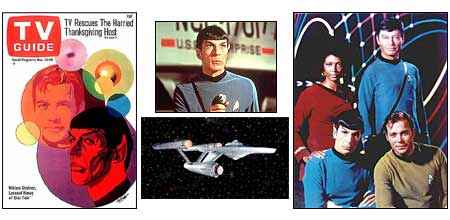Star Trek

Synopsis of TV Show
“Space, the final frontier. These are the voyages of the Starship Enterprise on her five-year mission to seek out new life and new civilizations, to boldly go where no man has gone before...”
Star Trek creator Gene Roddenberry first started to write in the South Pacific, where he was stationed as a pilot during World War II. He sold flying stories to magazines and poetry to the New York Times—worthy of mention because both areas of expertise, the literal adventure narrative and the not-so-literal poetry, would figure into his beloved franchise later on. Roddenberry returned from the war and landed in Hollywood, where he wrote for shows like Have Gun, Will Travel and Dragnet before NBC agreed to his pilot idea for a “wagon train to the stars” type of show.
A TV pilot was filmed, but the network wasn't satisfied. Worried execs thought Spock looked scarily devilish, and that the stories had no action/adventure spark. But Roddenberry and his team went back to the drawing boards, and after a second pilot, Star Trek finally debuted in the fall of 1966. The cast, which was reshuffled after the pilots, consisted of Captain Kirk, who ran the show; the half-Vulcan/half-human first officer Mr. Spock; ship doctor Bones McCoy; engineer Scotty; navigator Hikaru Sulu; communications officer Lieutenant Uhura; nurse Christine Chapel; and starting in 1967, Ensign Pavel Chekov. Together, crew of the U.S.S. Enterprise followed the United Federation of Planet’s Prime Directive: to discover and befriend life forms on other planets, without disturbing the success of those planets’ civilizations. With a wide-open premise like that, and a setting in the 23rd century, adventure and poetry were more than possible.
Roddenberry was never interested in making a ‘humans vs. aliens’ laser gun fest. As a technology buff and a burgeoning futurist, he was much more interested in social satire, in veiled examinations of racism and politics, and of course, in mind-tweaking sci-fi notions of the ‘what’s out there, and how do we fit into it?’ ilk. The show’s characters were complex—heroic usually, but not without their flaws. Captain Kirk could be too impetuously emotional and Spock too narrow-mindedly rational, which of course left the dry-humored McCoy all too ready to poke fun at his pointy-eared, green-pallored shipmate.
Though the Star Trek franchise is a veritable phenomenon nowadays, the show’s ratings in that original late 60’s run weren’t so stellar. After its second season, it teetered on the brink of cancellation, but was saved by a massive letter-writing campaign. Though they agreed to a third year, the network brass moved the show to Friday nights at 10—the so-called ‘death slot’—much feared in the TV business because viewers weren’t typically home, or at least they weren’t inclined to plant themselves in front of the tube. And a death slot it was. The show was cancelled after its third year.
But Star Trek’s posthumous success has been like no other. Those 79 original episodes and that memorable cast inspired an animated series, several feature films and TV movie specials, three series spin-offs, plenty of product merchandise, and legions of fans who perpetuate the show’s mythology with literature and websites and conventions.
In its inaugural three years, the show’s viewership consisted mainly of youths, and back then, the youth demographic wasn’t considered the goldmine it is today. But when the show was syndicated, those youthful early fans re-watched and new fans got hooked—now the viewership was kids and adults. Fans went from being called a ‘following’ to a ‘cult following,’ and then back to just ‘following’ again—a cult implies a limited number of participants, and the number of Star Trek’s fans was anything but limited.
Kirk’s ever-changing waistband measurements, the engineer specs of the U.S.S. Enterprise, the feasibility of warp-drive engines fuelled by anti-matter, the Cold War era parallels between the belligerent Klingons and the Communists, TV’s first inter-racial kiss and endless discussion of episode subtext…all of it can be looked up, argued over, and made the subject of the informal Star Trek trivia contests that are probably going on somewhere close to you right now, whether you know it or not. Devotion, thy name is “Trekkie” (or “Trekker,” depending on which you prefer).
NASA named its prototype space shuttle the Enterprise in response to a yet another Trekkie mail drive, and an model of the great ship rests in the Smithsonian Air & Space Museum in Washington, D.C., on the same floor as the Wright Brothers’ first flyer and Charles Lindbergh’s Spirit of St. Louis—just to give you an idea of how this it has been woven into our cultural identity’s always-colorful fabric. It's a Star Trek universe—the rest of us are just carbon-based life-forms with curious emotions and a severe lack of Phasers.
Spock: “Random chance seems to have operated in our favor.”
McCoy: “In plain, non-Vulcan English, we've been lucky.”
Spock: “I believe I said that, Doctor.”
Release History of Prime Time Show
9/8/66 - 9/2/69 NBCTV Sub Categories
dramasci-fi/fantasy
Television Network
NBCTelevision Studio
Paramount TelevisionTV Cast
Captain James Tiberius Kirk William ShatnerFirst Officer/Science Officer Lt. Cmdr./Cmdr. Spock Leonard Nimoy
Chief Medical Officer Lt. Cmdr. Leonard Horatio 'Bones' McCoy, M.D.* DeForest Kelley
Chief Engineer Lt. Cmdr. Montgomery 'Scotty' Scott James Doohan
Security Chief/Navigator Ensign Pavel Andreievich Chekov Walter Koenig
Communications Officer Lt. Nyota Uhura Nichelle Nichols
Flight Control Officer Lt. Hikaru Sulu George Takei
Christine Chapel, R.N.* Majel Barrett
Yeoman Janice Rand (1966) Grace Lee Whitney
Lieutenant Kevin Thomas Riley (1966) Bruce Hyde
Transporter John Winston
